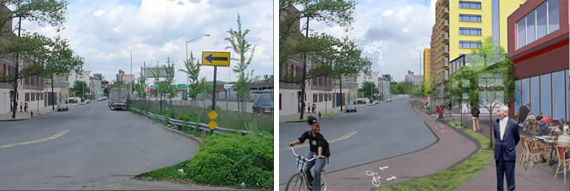The Winning Transpo Formula for a Third Term: Sustainability + Populism
 Mr. Bloomberg, tear down this highway. A vision of West Farms Road with housing and shops instead of the Sheridan Expressway. Image: South Bronx River Watershed Alliance.
Mr. Bloomberg, tear down this highway. A vision of West Farms Road with housing and shops instead of the Sheridan Expressway. Image: South Bronx River Watershed Alliance.Following Tuesday’s citywide elections, Streetsblog asked leading advocates and experts to lay out their ideas for the next four years of New York City transportation policy. What should the Bloomberg administration try to accomplish? Kate Slevin, executive director of the Tri-State Transportation Campaign and editor of its excellent blog, Mobilizing the Region, kicks things off with today’s installment.
The headlines after last week’s mayoral contest weren’t kind to the winner. "NY Voters Seen Wanting More Humble Bloomberg," proclaimed Reuters. "Bloomberg Sweats Out Third Term," wrote the Post. The incumbent’s slim margin of victory points to two major takeaways from campaign season in New York City: 1) Mayor Bloomberg is seen as out of touch with everyday New Yorkers, yet 2) was reelected, grudgingly, because the electorate thinks he is doing a decent job.
First up: Publicly support the removal of the Sheridan Expressway as a green jobs program.
Over the next four years, the mayor has an opportunity to rebuild the public’s trust and reverse the perception that he doesn’t care about the average citizen. It’s in his best interest to spend significant time on the latter. A wealthy, assertive politician can seem arrogant to voters in the best of times, and third terms are notoriously difficult for elected officials. If the mayor wants to create a legacy that builds on his existing record, he will have to prove that his policies, including transportation, help working New Yorkers. Here are four ways to help get him there, starting with the most specific.
First up: Publicly support the removal of the Sheridan Expressway as a green jobs program. This highway is a redundant, little used stub running through the Hunts Point community of the South Bronx. For nearly a decade, advocates in the South Bronx River Watershed Alliance (including the Pratt Center, Nos Quedamos, Youth Ministries for Peace and Justice, The Point, Sustainable South Bronx, and my organization, Tri-State Transportation Campaign) have called on the New York State DOT to remove the highway. Doing so would create 700 permanent jobs and hundreds of construction jobs, improve access to the Bronx River, and open up 28 acres for parks and affordable housing.
Bulldozing acres of parks for the new Yankee Stadium gave the impression that the mayor was more willing to help out developers than the average Bronx resident. Removing the Sheridan would help pay back that debt, and fit naturally with the Mayor’s long-term sustainability agenda, PlaNYC 2030.
Next, the Mayor should commit to boosting New York City’s funding for public transit.
During his campaign, Bloomberg announced an ambitious mass transit proposal. Like any good campaign document, the plan would improve the quality of life in all five boroughs, especially neighborhoods underserved by transit, like eastern Queens. But few of the proposals are under the mayor’s control and all of them require money. At a press conference last week, Bloomberg indicated that he doesn’t intend to boost city funding for MTA operations. He should reconsider. If the mayor wants support from the MTA, he must increase support to the MTA.
Third is to prioritize space for buses on city streets. The mayor should do all he can to ensure timely implementation of bold Bus Rapid Transit projects, as called for in PlaNYC, and help the Port Authority deal with the rogue buses that are increasingly affecting communities like Chinatown and Hell’s Kitchen. Better management will unclog the streets and improve the customer experience. (Believe it or not, those people lined up with their luggage on the sidewalks waiting for the Megabus are voters, too.)
Existing efforts to use city highways in a way that benefits working people in the outer boroughs should be preserved and expanded. Last year, the state DOT caved to politicians and started allowing cars with two or more passengers in the Staten Island Expressway bus lane. This is not only illegal (the lane was approved for buses only, not cars), but also hurt bus riders who are now slowed by greater congestion in the lane. Similar bus lanes should be put in place on highways throughout the city, a boon for New York’s car-free households, which make, on average, less than half as much as households with cars.
And finally, the mayor should recognize the work of NYCDOT Commissioner Janette Sadik-Khan by ensuring that she continues in her post for four more years. Sadik-Khan has become one of Bloomberg’s key spokespeople for PlaNYC. Her message about greening the planet with small changes to city streets resonates with the young, diverse population struggling to afford life in New York. In two-and-a-half years, Sadik-Khan and her staff have transformed a frustrating city agency whose biggest victory was speeding cars through Midtown into an international model for results-based sustainable transportation policy.
Mayor Bloomberg is already known as a skilled manager who gets things done. With a little effort, he can use transportation to expand his legacy as a leader in sustainability who stood up for the working people of New York.